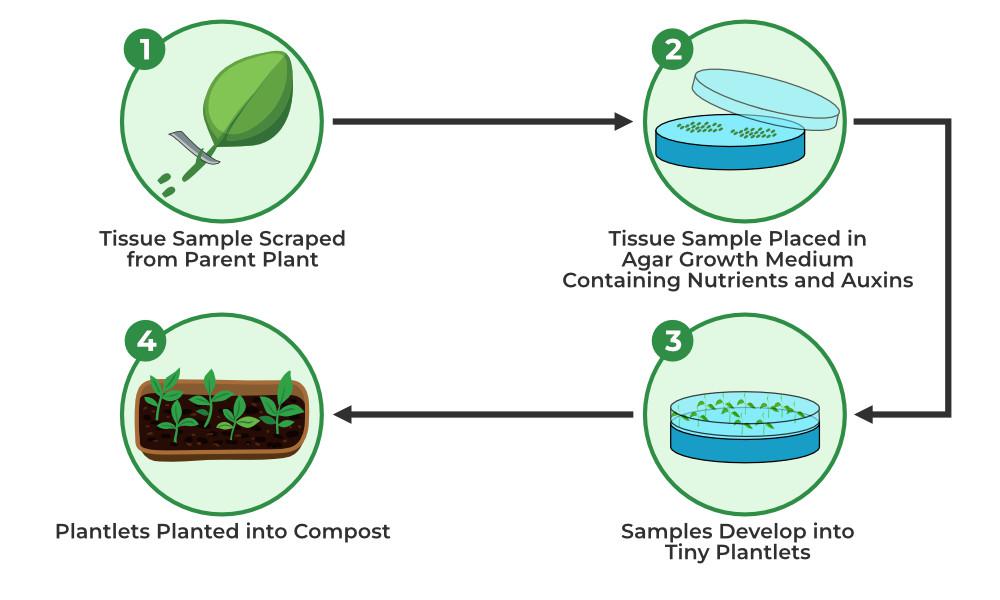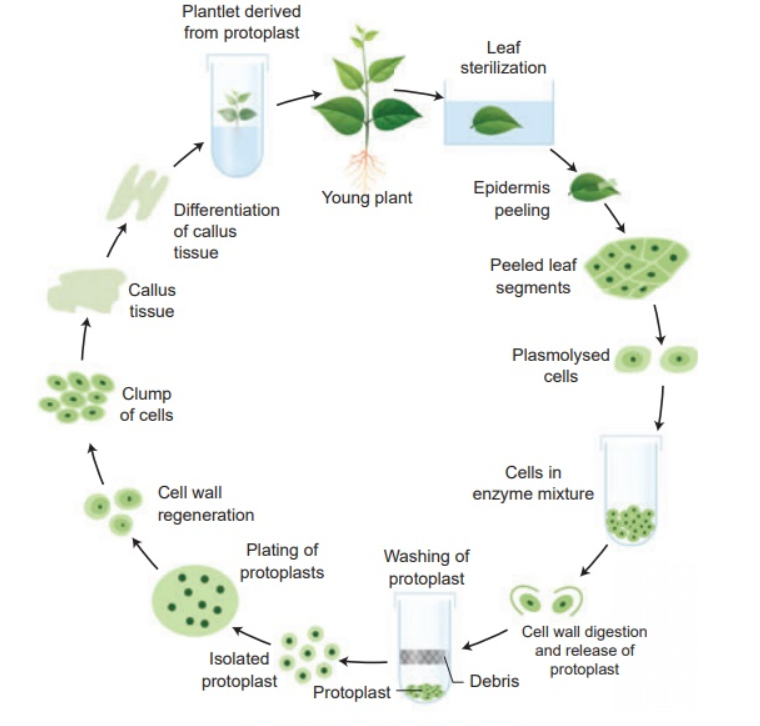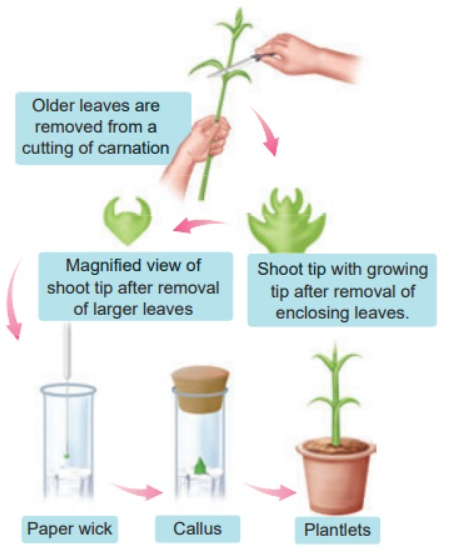One fascinating area of biotechnology is plant tissue culture, which provides a wealth of potential for manipulating and growing plant cells, tissues, and organs under controlled conditions. This method, which is effectively “cloning” plants, makes use of totipotency, the extraordinary capacity of plant cells to differentiate into any other kind of cell. Tissue culture has several uses, ranging from large-scale propagation to genetic engineering, which is transforming industries including conservation, horticulture, and agriculture.
The father of plant tissue culture is Gottlieb Haberlandt, an Austrian botanist who, in 1902, introduced the concept of cultivating isolated plant cells in vitro. He proposed that individual plant cells possess totipotency the potential to develop into a complete plant. Although his initial experiments did not result in cell division, his pioneering ideas laid the foundation for modern plant tissue culture techniques. Haberlandt’s work has significantly influenced advancements in plant biotechnology, agriculture, and conservation.

Summary of plant tissue culture
- Plant tissue culture involves growing plant cells or tissues in a sterile, nutrient-rich environment, enabling the development of whole plants from small tissue samples.
- This technique allows for rapid multiplication of disease-free, genetically uniform plants, supports genetic modifications for improved traits, and aids in conserving rare or endangered plant species.
- Various methods, such as callus culture, embryo culture, and meristem culture, are employed based on specific objectives like mass propagation, genetic engineering, or virus elimination.
Table of Contents
An essential component of this discipline is comprehending the various tissue culture varieties, each designed for a particular use. These kinds are basically categorized according to the kind of plant material that serves as the culture’s foundation:
Organ Culture
This technique uses whole organs as the initial explant, like roots, stems, leaves, or flowers, as the name implies. This method has the benefit of preserving the organ’s physiological processes and structural integrity, which makes it perfect for researching how organs evolve, react to stimuli, or even produce secondary metabolites.
Callus Culture
This kind starts with a little fragment of plant tissue and grows into an amorphous mass of cells known as a callus. This callus, which is just a “blob” of undifferentiated cells, has enormous potential since it can be made to develop into different plant organs. This makes it an essential tool for genetic engineering and plant regeneration.
Protoplast Culture

This cutting-edge method makes use of individual plant cells known as protoplasts that have had their stiff cell membrane removed. Because protoplasts are so sensitive and easily manipulable, they are useful for introducing foreign genes for genetic manipulation or fusing protoplasts from different species to form hybrids.
Embryo Culture
The goal of this technique is to grow immature embryos that are either produced in vitro or straight from the plant. Plant breeding programs are improved by the generation of viable embryos made possible by embryo culture, which frequently saves embryos from unsuitable crossings or those having developmental difficulties.
Meristem Culture

This kind makes use of the potential of meristematic tissues, which are roots’ and shoots’ tips made up of actively dividing cells. Because meristem culture is well known for producing disease-free plants, it is an essential technique for the conservation of endangered plant species as well as the propagation of valuable crops.
Anther Culture
This specific technique targets the male reproductive organs, anthers, to produce haploid plants. Haploid plants possess a single set of chromosomes, providing a unique advantage in breeding programs as they allow for rapid homozygous lines, beneficial for studying genetics and generating new varieties.
Application of Plant Tissue Culture
Growing plant cells, tissues, and organs in a controlled environment is known as “plant tissue culture,” and it is an important approach in many domains, such as:
Genetics in Plant Breeding
Fast propagation: It makes it possible to multiply superior plant kinds quickly, which speeds up breeding efforts by enabling the effective creation of genetically identical, disease-free plants.
Genetic transformation: Tissue culture makes it easier for desired genes to be inserted into plants, which results in the creation of better crop types with desired characteristics including increased nutritional value, resistance to herbicides, and pest resistance.
Clonal Propagation: The process of clonal propagation allows rare or endangered species to be preserved and propagated by creating clones with superior genotypes.
Farming and Horticulture
Creation of disease-free plants: By removing viruses and pathogens from plant materials, tissue culture produces healthier, more fruitful plants.
Propagation of hard-to-proliferate species: It makes it possible to propagate species, such orchids and other ornamentals, that are hard to propagate using conventional techniques.
creation of uniform planting material: It guarantees the creation of planting materials that are high-quality and uniform, which improves yields and maintains quality.
Biodiversity conservation: Tissue culture can support efforts to conserve biodiversity by helping to maintain and propagate endangered plant species.
Each type of plant tissue culture boasts unique advantages and limitations, making them suitable for diverse applications. Understanding these variations empowers researchers to select the most appropriate technique for their specific goals, contributing to the advancement of plant science and the optimization of plant production systems.
Conclusion
Plant tissue culture stands as a transformative technique in modern biotechnology, enabling the controlled growth and manipulation of plant cells, tissues, and organs. By leveraging the totipotency of plant cells, this method facilitates the rapid production of disease-free, genetically uniform plants, proving invaluable in agriculture, horticulture, and conservation efforts. From preserving endangered species to enhancing crop traits through genetic engineering, plant tissue culture continues to revolutionize plant propagation and breeding practices, offering sustainable solutions to meet global agricultural demands.
Frequently Asked Questions(FAQ)
Define Plant Tissue Culture?
One fascinating area of biotechnology is plant tissue culture, which provides a wealth of potential for manipulating and growing plant cells, tissues, and organs under controlled conditions.
List the types of Plant Tissue Culture?
The Types of Plant tissue culture,
Organ Culture
Callus Culture
Embryo Culture
Meristem Culture
Anther Culture
What are the importance of Plant tissue culture?
The importance of Plant Tissue culture.
Genetics in plants Breeding
Farming and Horticulture
Related Articles

